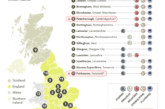
Simon Walker, National Director Public Sector at Watts, offers advice on taking the next step when it comes to achieving net zero.
So many organisations have set net zero carbon objectives but knowing where to start the journey can be a daunting task. At the same time an increase in the pace and scale of decarbonisation across the public sector estate is urgently needed to reach national targets — however there is help, funding and substantial guidance available.
Many local authorities and other public sector bodies have declared a ‘Climate Crisis’ but translating that to net zero carbon targets is a complex issue when considering diverse and often extensive property estates.
Retrofit of buildings to make them more energy-efficient is a key element of hitting these targets. The Government is providing significant financial support with over £1bn allocated for non-domestic public sector buildings, principally through the Public Sector Decarbonisation Fund — now up to Phase 3b of the scheme. The application window for this latest phase is now open — through the Salix Finance website. Phase 3b will provide up to £635m of funding from 2023 to 2025.
These funds come with tight deadlines for applications and delivery of projects — and organisations have to be prepared and ready to capitalise on these opportunities and to initiate projects quickly.
The first step in preparing for net zero is to set out the core objectives — then to establish a governance framework for how those objectives can be delivered across the estate and by who. The next requirement is a plan for how to deliver them through individual projects, with tailored solutions for individual buildings and sites. This often means retrofit of technology and fabric improvement.
There is a range of technologies available — and often it can feel like the Wild West in terms of what is credible and what isn’t — but increasingly there is very clever software available to help provide a headline analysis for each property of what works and what isn’t appropriate and how pay back periods and the business case can stack up. One such system is Ongen, more information on that is available here: https://ongen.co.uk/.
Whatever technology is chosen it should ideally tie in with specific measures to improve the fabric of the properties — which in turn requires an understanding of the condition of the estate’s buildings — but that’s best practice asset management.
For local authorities with a slightly more ambitious approach options include district heating and using the One Public Estate initiative to co-ordinate across the public sector. Usually powered by a low carbon energy centre, and capturing waste heat from sewers etc, district heat networks are popular on the continent. A current UK example is the Bristol City Leap programme, which will span the city, aiming to decarbonise the entire energy system by 2030.
Critically many organisations are on the same journey to net zero, at different stages perhaps, but help, and often funding, is available.
Watts provides property services including building surveying, project management, cost management and building services engineering services to both private and public sector clients, their technical knowledge and experience offers a collaborative way of working. More information on their services is available here www.watts.co.uk
Header image: One Angel Square — one of the most sustainable large buildings in Europe.
Image of Simon Walker: Copyright Owen Billcliffe at owenbphoto.com










